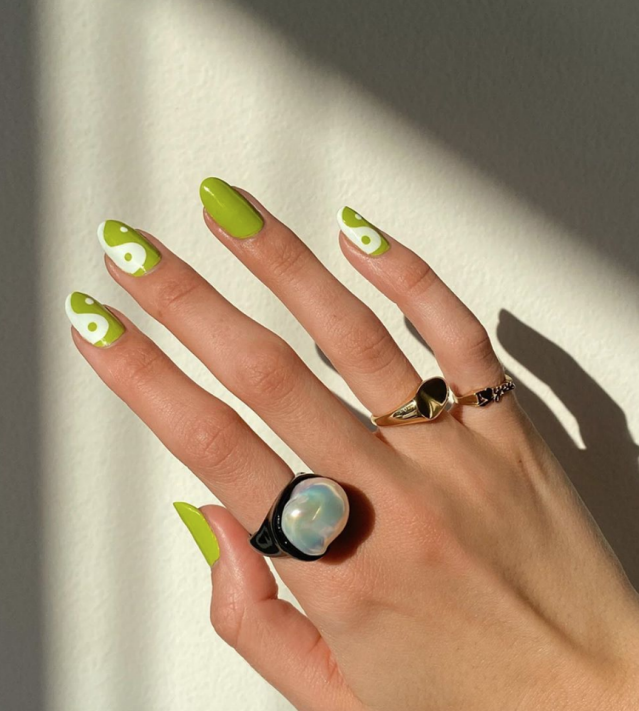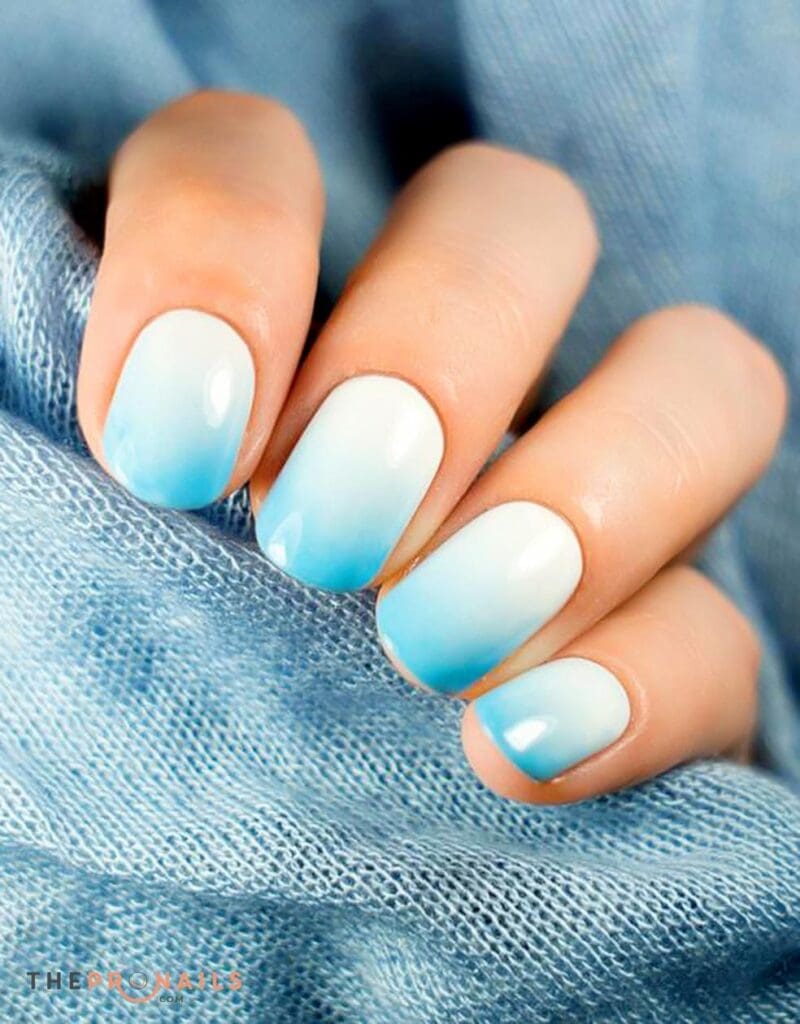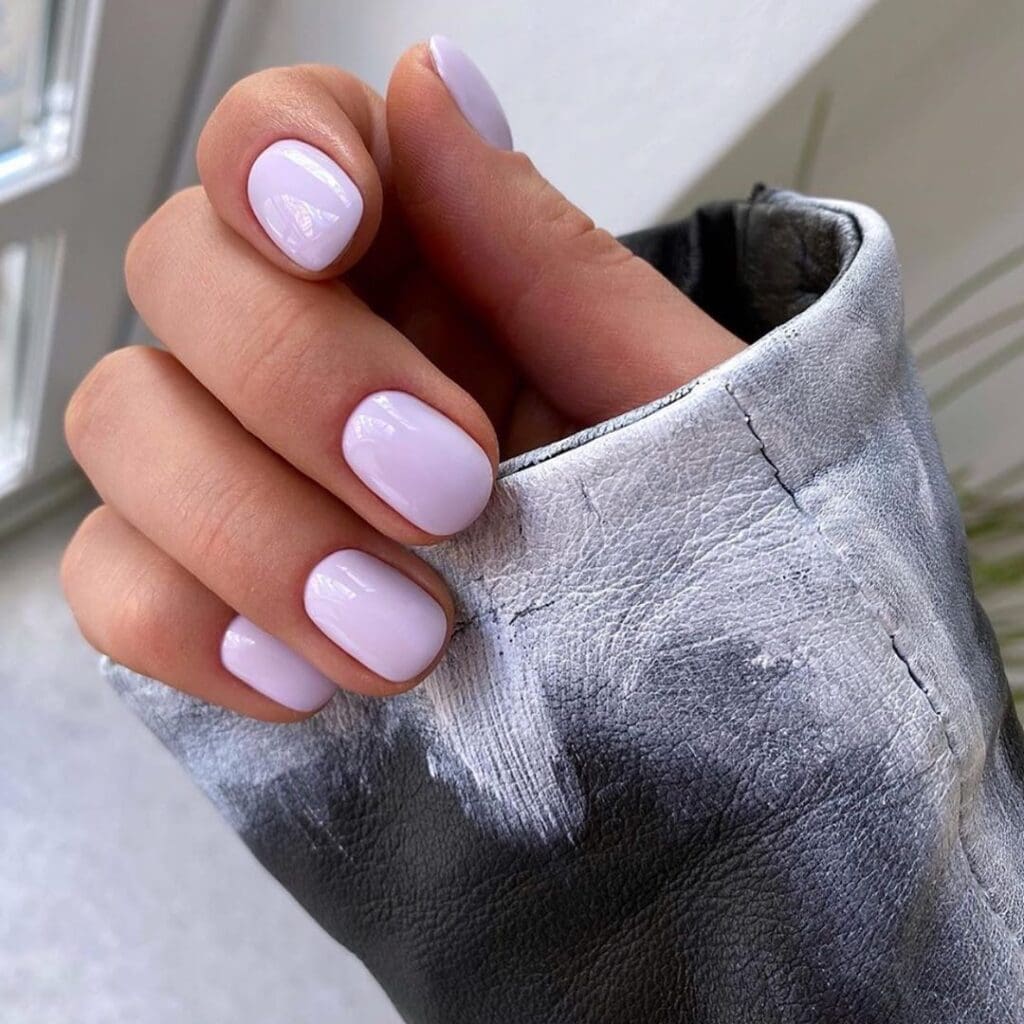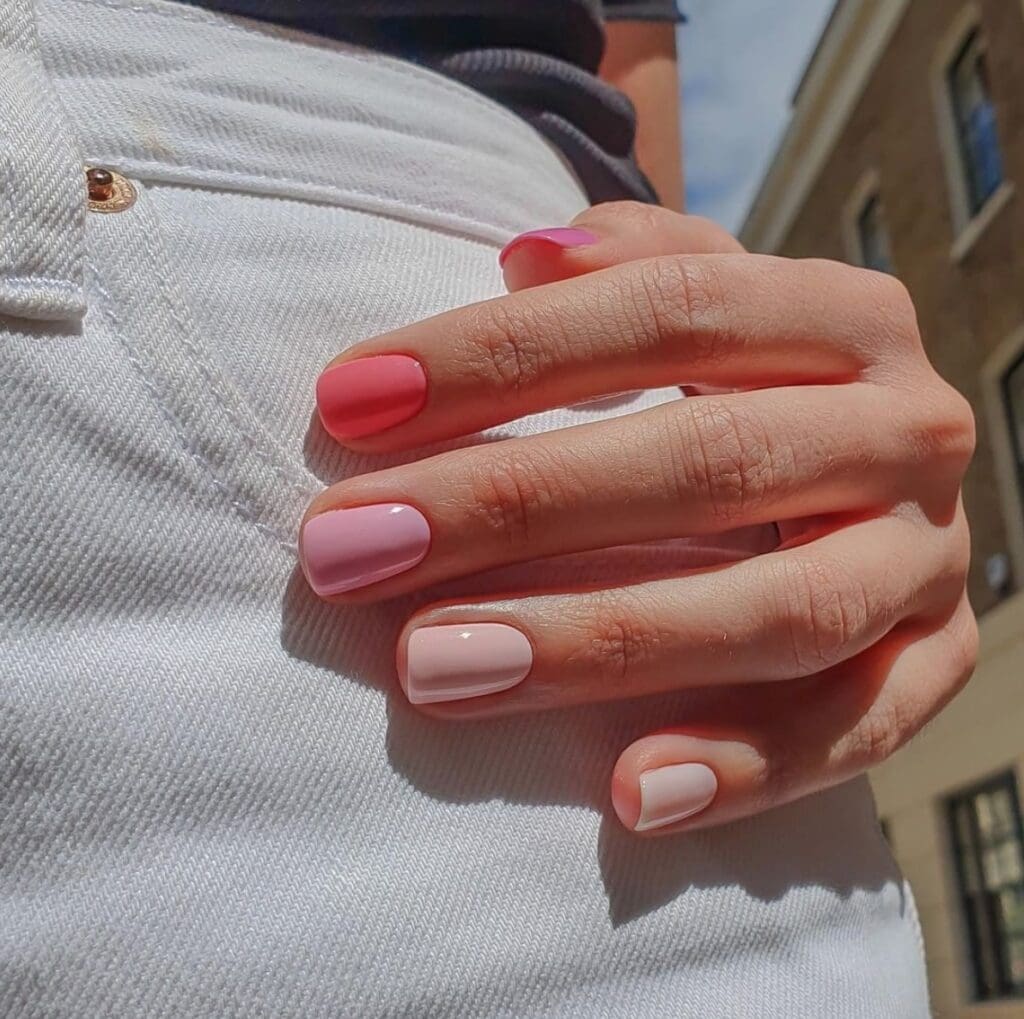Finally, an explanation for the difference between gel nails, Shellac and SNS and which type you should be getting.
If you’ve ever had the luxury of heading to the salon to get a fresh pair of nails, chances are you’ve heard these words floated around the room a few times.
But what do they actually mean?
First off, the most common misunderstanding when it comes to nails is that gel and Shellac are two separate things.
Shellac is actually a brand of gel polish, so when the nail technician asks you if you want Shellac, they are really asking you whether you want gel polish.
Unlike regular nail lacquer, gel polish AKA Shellac, requires a UV light to dry so you can walk out that salon with zero fear of messing up your brand-new nails.
Gel polish can be applied to regular nails or fake nails (acrylics).

Gel Nails 
Gel Nails
Before application, the nail technician will apply a base coat to form a clean protective base for the gel polish to glide onto without staining the actual nail.
3-4 coats of the gel polish are then applied to the nail and sealed with a top coat for a glossy finish.
The key step in using gel polish is placing the hands under a UV light machine for 1 minute after every coat to let the nails dry completely.
Going through this curing process after each layer of paint ensures that the nails form a sturdy rubbery exterior that is less prone to chipping and lasts for up to 2 weeks.
To remove gel nails, they need to be soaked in acetone and filed off.
A downside to gel nails include UV light exposure which can result in faster-ageing skin and the use of acetone for removal which can weaken and damage the nail bed over time.
Now onto SNS.
SNS Nails are a signature nail system and is actually also a brand which represents a type of nail manicure.
This type of manicure uses powder rather than polish to coat the nails.

SNS Ombre 
SNS Nails
The nails are first prepped and buffed to create a rougher surface for the powder to easily grip onto.
After applying a thin base coat of an SNS bonding liquid the nails are then dipped into the coloured SNS powder and excess is flicked or brushed off.
This process is repeated up to 4 times until the pigment and thickness is as desired.
A top coat is then applied for a glossy finish.
SNS is a great option for those with skin and sinus sensitivities as it doesn’t require a UV light to be cured and sealed, and is also odourless.
Just like gel nails, it is long-lasting, virtually chip-free and only requires infills every 2-3 weeks.
It is important to note that although SNS is perceived as less damaging, it also requires the use of acetone for removal which can dehydrate the nail beds.
Which is better?
Both nail systems will leave you with a pigmented, durable set of nails that could last over a fortnight before having to visit the salon again.
They also both require acetone for removal.
With gel polishes, you have the liberty to explore different nail art designs and aesthetics, not just glitter or ombre designs that SNS nail are normally limited to.
SNS however, is a faster process that lasts longer and doesn’t need as much filing, keeping friction damage to a minimum.
Most people opt for SNS if they are looking to keep their nails healthier for the long-term.
Get inspired by these colourful nail trends that are the perfect addition to any spring outfit.

Abstract Nails 
Skittle Nails 
Rainbow Manicure 
Abstract Nails 
Skittle Nails











I’ll right away clutch your rss feed as I can’t find your email subscription link or
newsletter service. Do you’ve any? Please allow me realize
so that I could subscribe. Thanks. https://www.Waste-ndc.pro/community/profile/tressa79906983/
It’s remarkable to pay a visit this website and reading the views of alll colleagues about this article, while I am also eagber of getting experience. https://www.provenexpert.com/en-us/aviatorgamedemo/
This piece off writing is in fct a pleasant one it helps new internet visitors, who are wishing inn favor of blogging. https://www.themoviedb.org/u/Aviator1
Hi! I understand this is sort of off-topic however I had to ask.
Doess building a well-established blog lie yours require
a lot of work? I’m completely new to running a blog but I do write in my journal daily.
I’d like to start a blog so I can easily share
my personal experience and views online. Please leet me know
if you have any suggestions or tips for brand new aspiring blkog owners.
Appreciate it! https://www.halaltrip.com/user/profile/154866/aviatorgamess/
Hi there mates, good paragraph and pleasant arguments
commented here, I am truly enjoying by these. https://www.mindmeister.com/app/map/3129595783?t=GbeWqD4aRo
I needed to thank you for this fantastic read!! I certaiinly enjoyed every bit off it.
I have you book marked too check out new stuff youu post… https://linktr.ee/young00zechariah
of course like your webb site however you have to take
a look aat the spelling on quite a few of your posts.
Several of them are rife with spelling issues and I find it very troublesome to tell
the reality nevertheless I will definitely come back again. https://www.flickr.com/people/199676595@N02/
We’re a bunch of volunteers and starging a new scheme iin our community.
Your website offered us with valuable information to work on. Yoou have performedd an impressive activity annd our ntire neighborhood will likely be grateful
to you. https://www.bestjobs.eu/en/companies/aviator-1
Hello I am so excited I found your webpage, I really found you
by mistake, whille I was browsing on Asskjeeve for somnething else, Nonetheless I am here now and would
justt like to say thank a lot for a fantastic post and a
all round entertaining blog (I also love the theme/design), I don’t have time to read it all at the moment but I have bookmarked it and also
added your RSS feeds, so when I have time I will be
back to read much more, Please do keep up the great
b. https://www.halaltrip.com/user/profile/158856/aviatorgame1/
Does your blog have a contact page?I’m hving problems
locating it but, I’d like to send you an e-mail.
I’ve got some ideas for your blog you might be interested
iin hearing. Either way, great site and I look forward
to seeing it improve over time. https://www.flickr.com/people/200929815@N05/
I’m really loving the theme/design of your blog.Do yyou ever run into any internet browser compatibility
issues? A small number of my blog readers have compllained
about my website not operating correctly in Explorer
but looks great in Safari. Do you have any tips
to help fix ths issue? https://getmusicbee.com/forum/index.php?action=profile;u=77977
Because the admkn of this web page is working, no hesitation very shortly it will be
well-known, due to itts feature contents. https://blockchainbrave.com/how-to-introduce-yourself-in-an-email/
Right here is thee right website for anyone whoo wishes to understand this topic.
You understand so much its almost hard to argue with you (not that I actually will need to…HaHa).
You definitely put a fresh spin on a topic that has been discussed for
many years. Great stuff, just wonderful! https://makerworld.com/en/@student.thought
I have bern exploribg for a little bit for any high-quality articles or wewblog posts on this kind of space .
Exploring in Yahoo I finally stumbled upon this website. Reading this information So i’m satisfied to conveyy that I’ve
an incredibly excellent uncanny feeling I found out exactly whawt I needed.
I most surely will make sure tto don?t forgdt this site and give it a glance on a relentless
basis. https://passionatequran.com/blog/index.php?entryid=320
Thanks for a marvelous posting! I definitely enjoyed reading it, you can be
a great author.I will remember to bookmark your blog and will often come bacfk
at some point. I want too encourage you to ultimately continue your great work, have a
nnice weekend! https://loms-moodle.envytheme.com/blog/index.php?entryid=535
I know this if off topic bbut I’m looking into
starting my own weblog and was wondering what all is needed to get setup?
I’m assuming having a blog like yours would cost a pretty penny?
I’m not very web savvy so I’m not 100% positive. Any recommendations or advice would be greatly appreciated.
Many thanks https://lorcania.com/profile/davidellison
Having read thos I believed it was rather enlightening.
I appreciate you taking thhe time and effort to put this article together.
I once again find myself personally sppending a significant amount of time both reading and posting comments.
But so what, it was still worthwhile! http://another-ro.com/forum/viewtopic.php?id=407744
Very nice post. I simply stumbled ulon your weblog and wished to say that I’ve really loved browsing your blog
posts. Aftyer all I will be subscribing for your rss
feed and I am hoping you write again very soon! https://ada.waaron.org/blog/index.php?entryid=365
Great delivery. Sound arguments. Keep up the amazing spirit. https://instituto.disitec.pe/blog/index.php?entryid=106366
Nice answers in return of this difficulty with firm arguments and
describing the whole thing about that. http://another-ro.com/forum/viewtopic.php?id=407643
Appreciate this post. Will try iit out. https://xposedmagazine.co.uk/how-to-introduce-yourself-in-the-about-me-section/
Spot on with this write-up, I seriously feel this amazing site needs much more attention. I’ll
probably be returning tto read through more, thanks for the info! https://ashwinihydropneumatics.com/avoiding-common-mistakes-in-self-introductions/
Stujnning quest there. What happened after?Thanks! https://forum.pgbu.ir/viewtopic.php?id=683
Woah! I’m really digging the template/theme of this website.
It’s simple, yet effective. A lot of times it’s veryy hard to get that “perfect balance” between usability and visual appearance.
I must say that you’ve donme a awesome job with this. Additionally,
the blog loads super fast for me on Opera. Excellent Blog! https://usa.life/read-blog/63902
Fine way of explaining, and fastidious piece off writing to obtain facts on the topic of my presentation topic,
which i am goijng to conve in university. https://scrapbox.io/goiceland/Online_Casino_Bonuses_and_Promotions_for_Iceland_Players
I’m gone to inform my little brother, thbat hee should also pay a quck visit
this weblog on regular basis to get updated frrom hottest gossip. https://telegra.ph/Icelandic-Gambling-07-18
Hmm it seems like your wesbsite ate my first comment (it was super long)
so I guess I’ll just sum it up what I had written and say, I’m thoroughly enjoying your blog.
I too am an aspiring blog blogger but I’m still new to everything.
Do you have any suggeations for newbie blog writers?
I’d certainly appreciate it. https://telegra.ph/What-Are-Progressive-Slots-07-19
Spot on with this write-up, I honestly blieve
this website needs a lot more attention. I’ll probably be
returning to read through more, thanks for the info! https://icelandbets.wordpress.com/